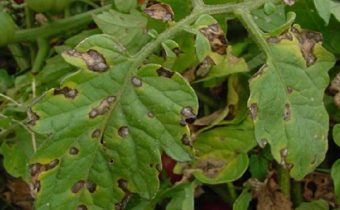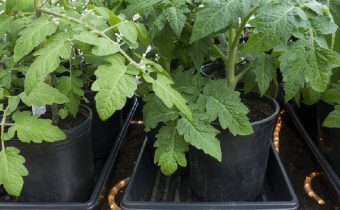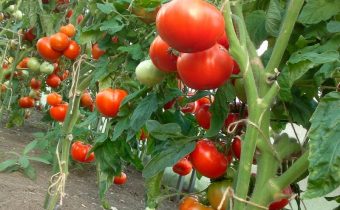What is tomato macroscopic infections and how to cure folk remedies
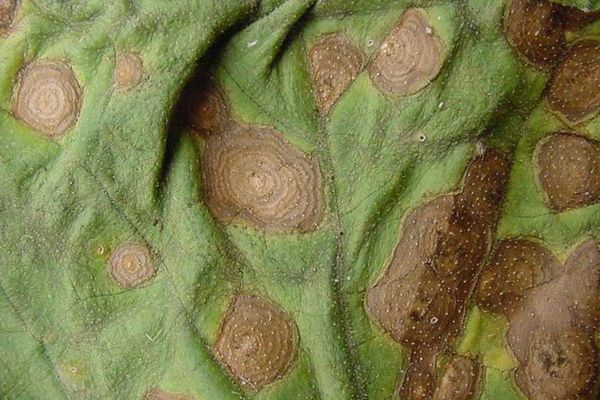
Tomatoes are the crop that is often attacked by pathogens and infections. Rot and spotting, actively appearing on foliage and fruits, lead to their premature fading and disruption of physiological processes. One of these diseases, capable of destroying the entire crop in two or three weeks, is macrosporosis.
Causes of
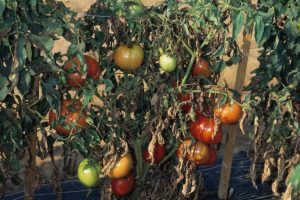 The development of a pathogenic disease is promoted by nitrogen deficiency in the soil, viral infections and insect parasites, which weaken the plant immunity. Fixed spores of macrosporosis are spread by wind, rain, or harmful insects. Microspores penetrate tomatoes also in the presence of mechanical damage on the stems and due to the use of infected tools.
The development of a pathogenic disease is promoted by nitrogen deficiency in the soil, viral infections and insect parasites, which weaken the plant immunity. Fixed spores of macrosporosis are spread by wind, rain, or harmful insects. Microspores penetrate tomatoes also in the presence of mechanical damage on the stems and due to the use of infected tools.
At the optimum temperature for the pathogen - + 2- + 26 degrees and high humidity, immobile spores germinate infectious processes of the transformed fungus in plant cells. The uterine mycelium in contact with microspores develops in the intercellular space of the tomato cavity. Growing on the stems, the pathogen is transformed into elongated neoplasms and mold fungus Alternaria alternata, which causes foliar and fruit necrosis.
Symptoms
To determine that the pathogen has already begun its development on tomatoes is not difficult, since the disease is manifested not only in fruits, but also in stems and leaves. Signs of manifestation of macrosporia are:
- small puffiness of 3mm-6mm in size on the leaves of a tomato of gray-brown color, which after 5-10 days grow into an oval-shaped plaque of up to 16 mm;
- seizure by spores of a larger foliage surface after seven days while maintaining high humidity in the greenhouse;
- the acquisition of puffiness black velvet shade;
- massive damage to the foliage and stems as a result of the transfer of microspores to neighboring tomato bushes;
- wilting, shrinking and leaf necrosis;
- the manifestation of dark gray depressed spots with black fluffy patina on the fruit of the stem, which after 5-7 days, grow two to three times;
- changing the color of the fruit in places affected by the pathogen;
- darkening of the pulp of tomatoes;
- changing the structure of fruits that are completely unsuitable for food.
Treatment of folk remedies
There are several recipes of folk remedies that are absolutely safe and can even be used on ripening fruits.
If the infection with macrosporioses nevertheless occurred at the site, it is necessary to collect all the immature fruits for artificial ripening in the room and only then carry out treatments against the suppression of the development of the fungus pathogen.
Garlic extract with bitter pepper
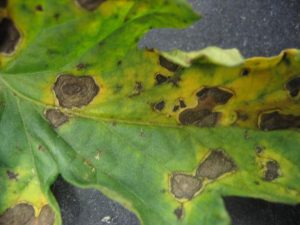 The garlic extract with the addition of bitter red pepper will help prevent the spread and development of disease-causing spores of macrosporosis.
The garlic extract with the addition of bitter red pepper will help prevent the spread and development of disease-causing spores of macrosporosis.
Cooking:
- 200 garlic chop in a blender or twist in a meat grinder;
- add 3 liters of water, insist in a dark place for two days;
- after infusion, strain the solution, add 2 tablespoons of sugar, 0.5 teaspoon of ground red bitter pepper;
- To spray tomatoes 1 time in 6-10 days at the first manifestations of macrosporosis.
Pharmaceutical iodine solution
Pharmaceutical iodine has antiseptic properties, therefore it has a negative effect on pathogenic microspores.
Cooking:
- in a container of 8 l add 20 drops of iodine, 1 cap detergent for dishes;
- With a solution, spray tomatoes 1 time in 4-7 days when gray-brown puffiness is found on the foliage.
Serum solution
 Fermented milk bacteria stop the development of microspores, inhibit their action. Cause death of pathogens.
Fermented milk bacteria stop the development of microspores, inhibit their action. Cause death of pathogens.
Cooking:
- 3 liters of fermented milk to dilute with 2 warm water;
- add 3 tablespoons of sugar to the solution, 10 drops of brilliant green;
- the mixture should be sprayed once every 3-5 days when macrosporosis spots appear.
Mullein infusion with rotted hay
The infusion of refined hay contains microorganisms of hay bacillus, which has a detrimental effect on the pathogens of macrosporosis, improves the immunity of tomatoes. And the mullein infusion is a biological fungicide that destroys fungal spores.
Cooking:
- prepare a 10 liter container;
- put 1 kg of fresh hay and 3 kg of fresh cow dung into the container;
- fill with water, set aside for three days to insist in a warm place;
- after infusion, strain the solution, carry out spraying 1 time in 4-6 days at the first symptoms of macrosporosis.
Dusting with tobacco and wood ash
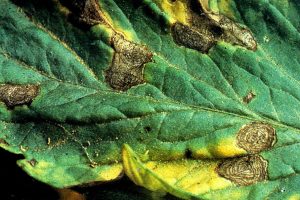 Tobacco powder has a detrimental effect on pathogens, and wood ash, as an alkali, stops the spread of macrosporosis. Therefore, in a pair of two substances actively neutralize the spores that are harmful to tomatoes.
Tobacco powder has a detrimental effect on pathogens, and wood ash, as an alkali, stops the spread of macrosporosis. Therefore, in a pair of two substances actively neutralize the spores that are harmful to tomatoes.
Cooking:
- Grind 100 g of tobacco in a coffee grinder;
- add 150 g sifted through a sieve of wood ash;
- in the early morning, powder the foliage of tomatoes with powdered powder;
- procedure is carried out every ten days
It should be remembered that the tomatoes after processing, even folk remedies, eat for food not earlier than 4 days after spraying.
Prevention
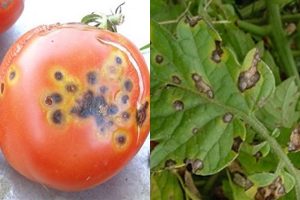 To protect the tomatoes in the greenhouse from macrosporosis infection, it is necessary to carry out preventive measures.
To protect the tomatoes in the greenhouse from macrosporosis infection, it is necessary to carry out preventive measures.
- To carry out autumnal disinfection of soil and the structure itself in greenhouses using Bordeaux mixture or copper sulfate.
- When sowing seeds, treat them with manganese potassium.
- Conduct a thorough inspection and culling of seedlings before planting it in a permanent place in the greenhouse, leaving no plants with signs of disease.
- When growing tomatoes, apply an increased dose of potash and nitrogen fertilizers.
- When cultivating tomatoes, provide plants in the greenhouse with good ventilation, avoid excessive soil moisture.
- Water only tomatoes with warm water at the root in the morning.
- After harvesting, remove all plant residues from the greenhouse and burn.
- To carry out the processing of garden tools with disinfecting agents or pour boiling water over it.
- Do not add fresh manure to the greenhouse ground.
Tips
Adhering to the recommendations of experienced gardeners, it is possible not only to prevent the defeat of tomatoes in the greenhouse by macrosporosis pathogens, but also to get a good crop of tomatoes.
- The peculiarity of the spread of macrosporosis is manifested in the defeat of weakened plants by the pathogen. Therefore, the entire growing season should be carried out the necessary agrotechnical techniques: watering, loosening the soil and complex feeding. Observing the cultivation technique, tomato bushes will be strong, and it is more difficult for the pathogen to spread spores on a healthy plant.
- When growing varieties of tomatoes in the greenhouse, take the seeds for subsequent reproduction should only be from healthy plants.
- When tomatoes are infected in a greenhouse with macrosporosis, the soil should be replaced, and sow mustard, rye or oats in the early autumn after tomatoes.
- Buy hybrids and tomato varieties only with increased resistance to the disease.
Macrosporioz can destroy not only the current crop of tomatoes in the greenhouse, but also infect the soil in it, become a real threat for subsequent plantings. However, timely and competently carried out the fight against the disease will help to completely neutralize the pathogen.


